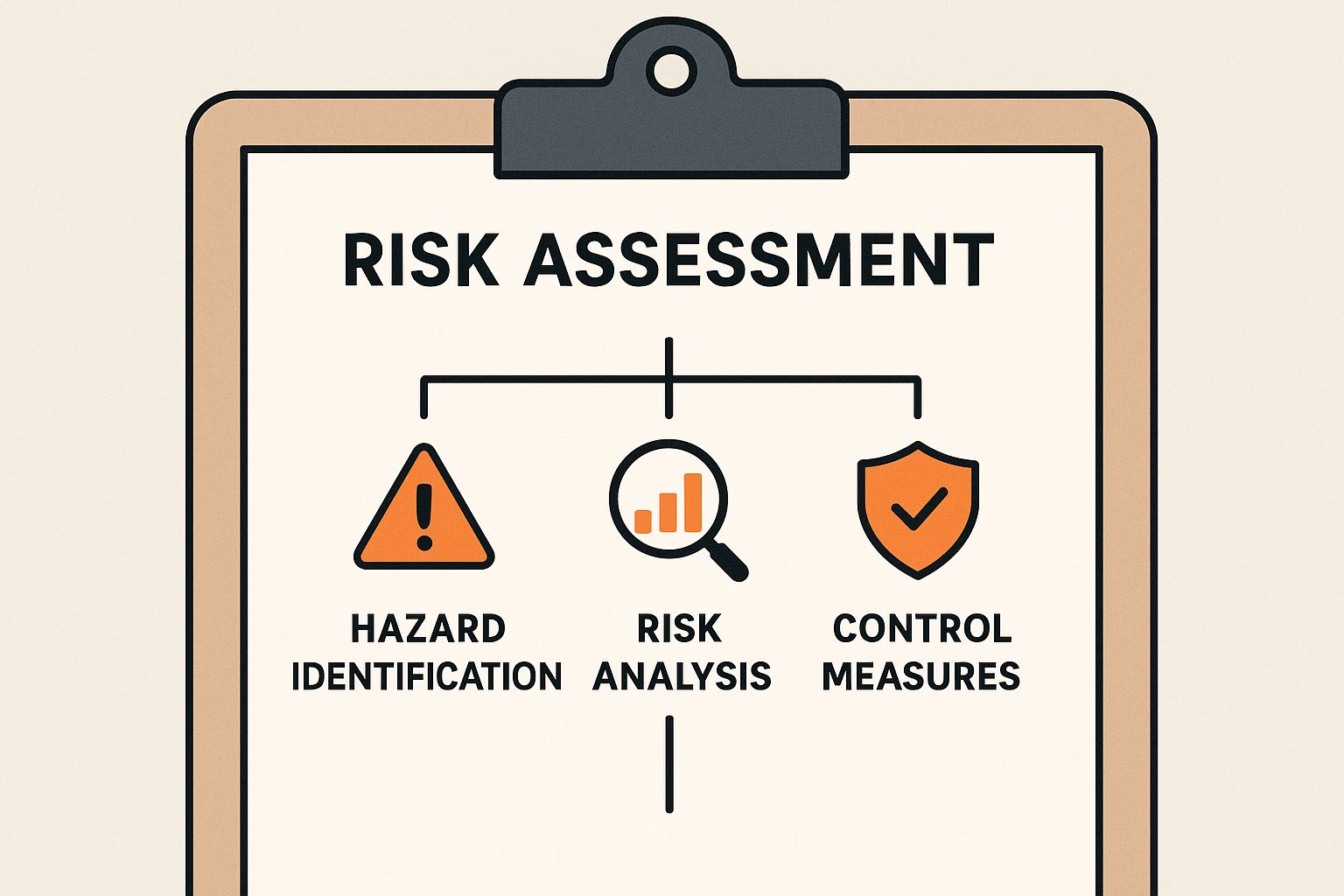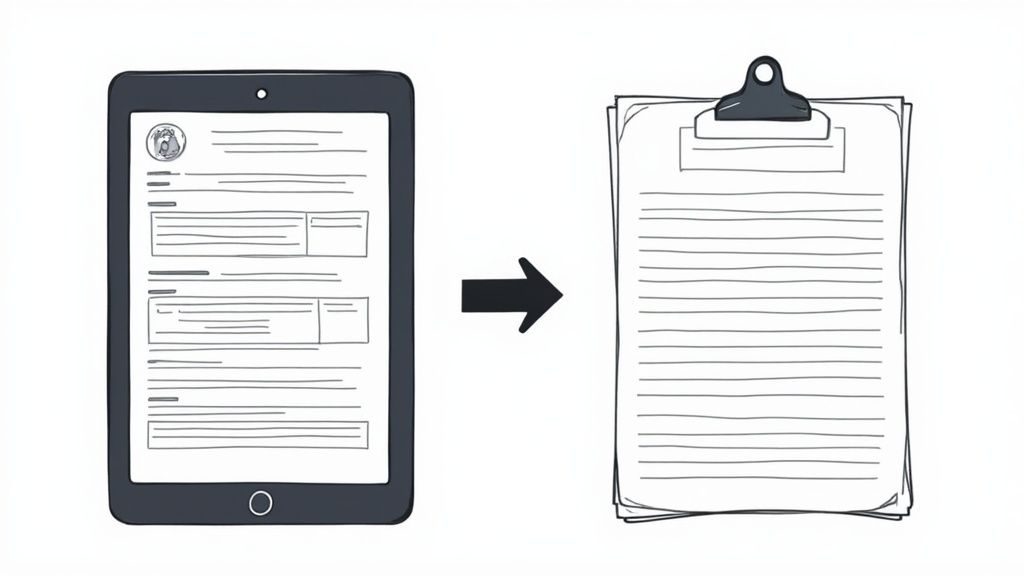Let's be honest, the term ‘risk assessment form’ can sound like another piece of administrative busywork. But in reality, it's your practical game plan for keeping people safe on site. It’s not just about ticking boxes; it’s a structured tool that helps you stop and think about what could go wrong before it actually does.
This document is where good intentions become a concrete plan of action.
What a Risk Assessment Form Actually Is

Think of a risk assessment form as the script for a safety conversation. Whether you’re on a bustling construction site or a noisy factory floor, these forms walk you through a simple, logical sequence.
First, you identify the potential hazards. Then, you figure out who could get hurt and how badly. Finally, you lay out the sensible, practical steps you’ll take to stop it from happening. It’s a deliberate process designed to prevent injuries before they occur.
The Core Purpose of These Forms
The main job of a risk assessment form is to create a clear, documented record of your safety thinking. It translates those abstract safety goals in your head into specific, actionable steps that your team can follow. This makes sure nothing critical gets overlooked and that everyone is on the same page.
A well-completed form delivers on a few key functions:
- Hazard Identification: It forces a thorough scan of a task or area to list every potential source of harm, from moving machinery and hazardous substances to simple trip hazards like a stray power cord.
- Risk Evaluation: It helps you weigh up the likelihood of something going wrong against how severe the consequences would be. This is crucial for prioritising your efforts.
- Control Planning: It’s where you document the specific controls you'll implement to either eliminate the risk or reduce it to an acceptable level.
- Communication Tool: It clearly communicates the known risks and required safety procedures to every worker, supervisor, and manager involved in the job.
A good risk assessment form doesn’t just list problems. It sparks a conversation about solutions and creates a shared commitment to putting those solutions into practice. It’s a tool for being proactive, not reactive.
Why This Matters in Practice
In high-risk environments like manufacturing and construction, site conditions can change quickly. A new piece of equipment arrives, a different subcontractor starts work, or the weather turns. A formal process ensures that safety checks are consistent and aren’t just left to chance or memory.
Using risk assessment forms creates a repeatable, reliable method for managing safety across different crews, shifts, and projects.
This documented approach is also your proof. It provides clear evidence that you have systematically considered the risks and taken reasonable, practical steps to protect your people. Ultimately, the form is less about filling out boxes and more about the structured thinking it drives. It makes safety a deliberate action, not an afterthought.
The Essential Parts of an Effective Form
A good risk assessment form is far more than just a box-ticking exercise. Think of it as a structured conversation, a roadmap that guides you logically through the process of making a task safer. To really work, it needs to prompt the right questions and capture the right details. Without a solid structure, crucial information gets missed, leaving you with dangerous blind spots in your safety plan.
The best forms are built for clarity and action. They slice the assessment into manageable chunks, making it dead simple for anyone on the team, from the apprentice to the site manager, to see the hazards and understand what needs to be done. It turns a potentially complicated task into a straightforward, repeatable process.
This infographic breaks down the core components into three simple stages: Hazard Identification, Risk Analysis, and Control Measures.

As you can see, each section flows into the next, creating a clear path from spotting a problem right through to documenting a fix.
Let's break down what each part of the form actually does. A well-designed form should have a logical flow, guiding the user from identifying the problem to implementing a solution. The table below outlines the key sections you'll find in any robust risk assessment form, showing not just what they are, but why they matter.
Key Sections of a Risk Assessment Form
| Section | Purpose | Example (Manufacturing Setting) |
|---|---|---|
| Task Description | Sets the context by clearly defining the specific activity being assessed. | "Clearing a jam from the main packaging conveyor belt." |
| Hazard Identification | Lists all potential sources of harm related to the task. | "Entanglement in moving parts (rollers, belt), electrical shock from exposed wiring, manual handling injury from awkward posture." |
| Risk Analysis | Evaluates the likelihood and severity of harm for each identified hazard. | "Entanglement: High Likelihood, Severe Consequence (requires urgent action). Electrical shock: Low Likelihood, Severe Consequence." |
| Control Measures | Details the specific actions that will be taken to eliminate or reduce the risk. | "Implement a full lock-out/tag-out procedure before clearing jams. Install a fixed guard over the main drive roller. Provide training on the new procedure to all operators." |
| Responsibility & Timeline | Assigns clear ownership and a deadline for implementing the controls. | "Person Responsible: John Smith (Maintenance Lead). Completion Date: 15/10/2024." |
| Review Date | Schedules a future review to make sure the controls remain effective. | "Review assessment on 15/10/2025 or if the conveyor system is modified." |
Each section builds on the one before it, making sure nothing is overlooked. It’s a methodical approach that leaves no room for ambiguity.
Identifying Hazards and Assessing Risks
The first part of any risk assessment form is all about discovery. This is where you get specific, detailing the exact task and then systematically listing every single thing that could possibly cause harm. Specificity is key here. "Dangerous machine" is useless. "Unguarded rotating gears on conveyor belt #3" is actionable.
Once you have your list of hazards, you need to figure out which ones to tackle first. This is where you assess the risk by asking two simple questions:
- Likelihood: How likely is it that something will go wrong?
- Consequence: If it does, how bad will it be?
Combining these two factors helps you prioritise. A hazard that is very likely to cause a serious injury obviously needs your immediate attention over something that's unlikely to cause a minor cut. Many businesses use a simple scoring system to keep this consistent. A risk management matrix is a great tool for guiding this scoring process and taking the guesswork out of it.
Planning and Assigning Control Measures
After you've identified and sized up the risks, it's time to do something about them. This is the action-oriented part of the form where you spell out exactly what will be done to make the job safer.
A control measure isn't a vague suggestion; it's a specific, concrete instruction. "Be careful" is not a control. "Install a physical guard over the gears and implement a lock-out procedure for maintenance" is a control.
Your form absolutely must include dedicated sections for:
- Proposed Controls: List the exact actions to be taken. No jargon, just plain language.
- Person Responsible: Name a specific person. This creates genuine accountability and stops tasks from falling through the cracks.
- Completion Date: Set a realistic deadline for when the control needs to be in place and checked.
Finally, every form needs a review date. Workplaces aren't static. Processes change, new equipment comes in, people move on. Risk assessments need to be living documents, reviewed regularly or whenever something changes. This process is often a cornerstone of creating effective Standard Operating Procedures (SOPs) that keep your safety instructions relevant and effective.
Understanding Your Legal Requirements in Australia

In Australia, getting your risk assessments right isn’t just good practice, it’s a legal must-do. Under Work Health and Safety (WHS) laws, every business has a primary duty of care to keep its people safe, as far as is reasonably practicable. A huge part of fulfilling that duty comes down to documenting your safety processes.
Think of it this way: your completed risk assessment forms are your proof. They show you’ve actually stopped, thought about what could go wrong, and put a solid plan in place to manage those risks. This is the heart of due diligence, proving you’ve taken every reasonable step to prevent someone from getting hurt.
Without that paper trail, it's just your word against everyone else's if an incident happens. When a safety inspector shows up, they won’t just ask if the site is safe. They'll ask to see your records, your risk assessments, and your thinking.
The Government's Approach to Risk Documentation
It helps to look at how the government handles its own risk management. They don't just wing it; they use structured, documented frameworks to make sure nothing gets missed. This isn’t just a bureaucratic quirk, it’s the national benchmark for responsible management.
Take any government policy toolkit, for example. You’ll find a mandatory process for methodically evaluating risk. It involves identifying what could go wrong, planning the fix, and assigning clear responsibilities and deadlines. That’s exactly what’s expected on a factory floor or a construction site.
This tells us one thing loud and clear: a clear, auditable trail is non-negotiable. By following a similar systematic approach with your own risk assessment forms, you’re aligning your business with what regulators expect to see. You can dig deeper into this in our guide on what WHS means for your business.
What This Means for Your Forms
The legal expectation isn't just about spotting a few hazards. It's about recording the entire end-to-end process on your forms.
Simply listing potential problems isn't enough. Australian WHS laws require you to show how you evaluated the risk, what you decided to do about it, and who is responsible for seeing it through. Your forms must tell the whole story.
This is exactly why a simple checklist often falls short. Your risk assessment forms need to be robust enough to stand up to scrutiny. They need to clearly map out your decision-making, showing you’ve been thorough and responsible in how you manage safety.
How to Customise Forms for Your Workplace
A generic risk assessment form you download off the internet is a starting point, not a solution. Every job site has its own unique quirks, machinery, and processes. Trying to use a one-size-fits-all document for a dynamic construction project or a factory with specialised equipment almost guarantees the most critical details get missed.
When a form isn't relevant to the actual work, your crew sees it for what it is: just another piece of paperwork. They'll tick the boxes without a second thought, completely defeating the purpose of the exercise. Customising your risk assessment forms is non-negotiable if you want them to be a useful tool that reflects the real-world conditions your team faces every day.

This isn't about reinventing the wheel. It's about taking a solid foundation and sharpening it to fit the specific contours of your operation.
Making Forms Relevant and Actionable
To turn a bland template into a useful safety tool, you need to add sections that speak directly to your workplace's real risks. This means getting specific and moving beyond broad categories.
Start by thinking about the unique elements of your work environment:
- Specific Equipment: Instead of a vague "machinery" section, list the actual high-risk plant your team uses. Create specific prompts like "pre-start checks for the CNC plasma cutter" or "safe operating zone for the 30-tonne excavator."
- Unique Environmental Hazards: Does your workshop deal with chemical fumes or deafening noise? Add a dedicated section to assess risks like chemical exposure, forcing a look at things like ventilation and the right personal protective equipment (PPE).
- Complex or Multi-Step Tasks: For complicated jobs, break the form down to match the workflow. A task like "installing roof trusses" could have separate sub-sections for "lifting and positioning" and "working at height."
The goal is to make the form so specific to the task that the person filling it out can’t help but think through the actual steps and risks involved. A generic form lets people guess; a custom one forces them to observe.
Practical Tips for Adaptation
When you’re tweaking your risk assessment form, get the people who will actually be using it involved. Your team on the tools knows the job better than anyone. Ask them what's missing from your current forms and what would make the whole process more practical.
Think about adding prompts that force detailed thinking:
- Instead of asking, "Are there any hazards?" try asking, "What could go wrong during the setup, operation, and pack-down phases of this task?"
- Add a field for "Permits Required," prompting users to confirm they have the right hot work, confined space, or excavation permits before a single tool is picked up.
By tailoring your risk assessment forms, you transform them from a compliance chore into a genuinely useful safety instrument that actually helps keep people safe.
Moving from Paper Forms to Digital Tools
Let's be honest, the old paper-and-clipboard approach to risk assessments is broken. It’s more than just a hassle; it’s a genuine weak link in a safety system. Paper forms get lost, coffee-stained, or damaged by rain. Handwriting can be impossible to read. The real work happens out on site, and your safety tools need to be right there with you, not stuck in an office.
Shifting to digital tools isn’t just a tech upgrade. It’s a practical move that solves these real-world problems. Digital forms bring the entire assessment process to the factory floor or construction site. Your crew can grab a phone or tablet and fill out detailed forms right where the work is happening. This means hazards are being documented in real-time, not from a tired memory at the end of a long shift.
The Practical Benefits of Going Digital
Once you move your risk assessment forms into a digital system, the advantages show up almost immediately. Information is no longer buried in a filing cabinet; it’s securely stored, neatly organised, and instantly searchable for audits or incident reviews. Having that history at your fingertips makes managing safety far more efficient.
The key benefits of a digital approach really speak for themselves:
- On-the-Spot Documentation: Workers can snap a photo or take a quick video of a hazard and attach it directly to the form. This provides clear, visual context that words alone could never capture.
- Clear Accountability: Digital platforms give you a clear audit trail. You can see exactly who completed a form, when it was submitted, and whether control measures have been actioned and signed off.
- Instant Distribution: Completed assessments can be shared instantly with supervisors, safety managers, and anyone else who needs to know, ensuring everyone is on the same page about risks and controls.
Using digital tools also opens the door to big efficiency gains through workflow automation in managing digital forms. It’s all about spending less time chasing paperwork and more time actually managing safety.
Gaining Better Insight from Your Data
This is where things get really useful. A digital system turns your collection of individual risk assessments into a goldmine of data. Instead of isolated paper documents, you have an organised database of safety information. This lets you spot recurring issues, identify high-risk tasks, or see which control measures are actually working in the field.
This data-driven approach isn’t just for individual businesses. Australia's landmark National Climate Risk Assessment (NCRA) shows how this methodology is applied on a massive scale. The assessment uses extensive data to manage complex, nationwide risks like extreme heat and flooding, guiding everything from infrastructure investment to policy planning. You can explore the full scope of this national safety strategy and read more about the NCRA findings.
Just like the NCRA uses data to plan for national challenges, your business can use the data from digital forms to build a more effective and responsive safety plan for your own workplace.
Moving to a digital system gives you the clear oversight needed to make genuinely informed decisions. It transforms your risk assessments from a static, box-ticking exercise into a dynamic tool for proactive safety management. If you're thinking about making the switch, our guide on choosing workplace health and safety apps that work offers practical advice on picking the right solution for your team.
Common Mistakes to Avoid When Using These Forms
Even the best-designed risk assessment form is useless if it’s not used correctly. Too often, they become just another compliance exercise, a box-ticking activity you file away instead of a practical tool that actually prevents someone from getting hurt.
Learning from common mistakes is one of the fastest ways to improve your entire safety process.
The biggest mistake is using forms that are too generic. A form that just says "assess machinery risks" is next to useless on a factory floor with a dozen different machines, each with its own quirks and dangers. It’s an invitation for lazy, copy-paste answers that don't reflect the real hazards of a specific task. When that happens, the whole process feels pointless to the people on the ground.
Another classic pitfall is failing to involve the people who actually do the work. A safety manager filling out a form from their office will always miss the small but critical details. The stuff a machine operator or a site labourer knows from years of hands-on experience. Cutting them out of the process doesn't just lead to a weak assessment; it sends a clear message that their expertise isn't valued.
Forgetting the Follow-Up
One of the most dangerous mistakes you can make is treating the form as a one-and-done task. A risk assessment isn't a static document you file and forget. It's a living part of your safety system that needs to be reviewed and updated.
Failing to pull out those forms after an incident or a near-miss is a massive missed opportunity. That form should be the very first thing you look at to figure out what went wrong and where the controls failed. It needs to be updated with what you’ve learned to stop the same thing from happening all over again.
Good risk management is a continuous loop of learning and adapting, not a one-off task. Your forms should always reflect your latest understanding of the risks on site.
The Problem with a 'Set and Forget' Mindset
This idea of continuous improvement isn't just a safety buzz-phrase; it's a core principle in Australian regulatory frameworks. Take the Tertiary Education Quality and Standards Agency (TEQSA), for example. They use a structured risk assessment framework that relies on multi-year data, like student and staff numbers, to constantly fine-tune the risk profiles of education providers.
Their evidence-based approach shows that proper risk management is all about ongoing analysis, not just a snapshot in time.
This holds a key lesson for any business using risk assessment forms. If your forms from last year look identical to this year's, despite changes in equipment, people, or the way you work, you’re probably just going through the motions. You can avoid these common traps by treating your forms as active tools for genuine, hands-on safety management.
A Few Common Questions
Got a couple of lingering questions about putting risk assessment forms into practice? Here are some quick, practical answers to the queries we hear the most.
How Often Should We Review Risk Assessment Forms?
A risk assessment is a living document, not something you file away and forget. As a rule of thumb, it should be reviewed at least once a year.
But more importantly, you need to update it the moment something changes. This could be anything from bringing in new equipment, tweaking a process, or after an incident or even a near-miss. Your form must always reflect the reality of the job, right now.
Who Should Fill Out a Risk Assessment Form?
It’s absolutely critical to involve the people who actually do the work. A safety manager can definitely lead the process, but it’s the workers on the floor who have the real, hands-on knowledge of the hazards involved.
They’re the ones who know which controls will work in a real-world setting and which ones are just theoretical. Getting them involved not only makes the assessment far more accurate, but it also gets everyone on board with the final safety plan.
Can I Use One Form for the Entire Worksite?
Generally, that’s not a good idea. A single, site-wide form is usually way too broad to be of any real use.
It's far more effective to create specific risk assessments for individual tasks (like 'operating a forklift'), certain areas (like the 'welding bay'), or even specific pieces of equipment (like a 'press brake'). This keeps each form focused, relevant, and genuinely practical for the people using it.
Ready to move beyond messy paperwork and confusing spreadsheets? Safety Space replaces outdated systems with a single, easy-to-use platform that makes managing safety simple. See how you can create, share, and track your risk assessments in real-time by booking a free demo.
Ready to Transform Your Safety Management?
Discover how Safety Space can help you build a safer, more compliant workplace with our comprehensive safety management platform.
Book a Free DemoRelated Topics
Safety Space Features
Explore all the AI-powered features that make Safety Space the complete workplace safety solution.
Articles & Resources
Explore our complete collection of workplace safety articles, tools, and resources.
